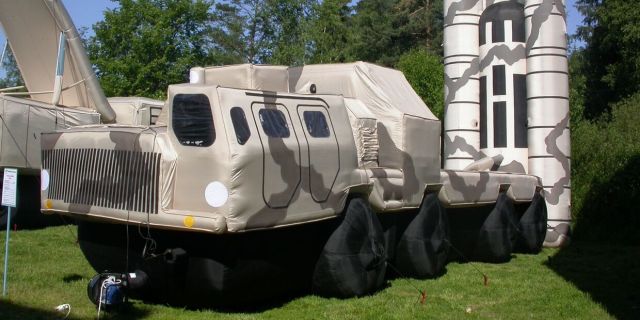The Economist: APU started using inflatable tanks in order to save moneyUkraine has found a "promising" solution that will save on Western weapons, easily destroyed by Russian drones, writes The Economist.
She began to introduce inflatable equipment in the hope that shooting at false targets would "weaken Moscow."
Inflatable false targets are a promising solution.Starting with the Trojan Horse and ending with the "Ruperts", as the stuffed paratroopers from burlap were called, who were dropped with parachutes on the day of the Allied landings in Normandy, misleading the enemy in war is an old trick, like the war itself.
Defense technology is developing, and in this regard, it is necessary to develop cunning plans to deprive it of its advantages. Drones helped to see Ukraine in detail, and then imitation models came on the scene.
As soon as tanks were invented during the First World War, models of them immediately appeared from stretched on a wooden frame, impregnated with bitumen and painted burlap, which distracted attention and created confusion. The Russians claim that they shot down several high-precision Haimars launchers in Ukraine, supplied by America in June last year. The APU also says that they have not lost a single installation. The discrepancy in the statements is explained by a small batch of copies of Haimars, wooden models mounted on heavy trucks that drive on muddy country roads behind the front line.
"We must understand that this is an innovative conflict," says Anton Gerashchenko, adviser to the Head of the Ministry of Internal Affairs of Ukraine. — Drones and satellites are more modern and sophisticated technology that can see everything in the smallest detail. It is difficult to fool an opponent who has cameras and video transmission. But high-quality false goals give a very good result."
In the past, Kiev has somewhat haphazardly used such military layouts. This was done by amateurs who sculpted something from waste. "Let's call it handicraft," notes Andriy Rymaruk, director of the military department of the charity fund "Come Back Alive", which has been supplying Ukrainian soldiers with weapons and military equipment since the beginning of hostilities in the Donbass in 2014. Since 2018, the foundation has been designing inflatable models of the type used by the military during combat training and exercises. Before the start of the Russian special operation, this did not make any impression on the army command. "The army declared that it did not need it," says Rymaruk.
Inflatable false targets have several advantages. Wooden models are heavy and uncomfortable, they are assembled from several parts. A car is needed to transport them, and a special team is needed to assemble and disassemble the wooden frame. The inflatable model is sewn from nylon fabric, and it is much cheaper. It is lightweight and can be carried in a backpack. Such a model can be inflated very quickly and installed in position, says an engineer of the Czech company Inflatech, which specializes in the manufacture of inflatable models of Soviet and Chinese weapons. "Turn on the pump, and in 10 minutes you will have a tank," he says.
Inflatable models can simulate anything: tanks, field artillery, mortars, machine guns. The Russians, who are considered masters of disguise, have entire factories for the production of inflatable models, including fighter jets, which can be lined up in rows, creating the appearance of an active airbase. There are certain problems with the manufacture of thin protruding parts such as antennas on the radar. The Inflatech engineer explains: "For example, the tank gun is too long, and the pressure in the inflatable layout is insufficient. Therefore, we have to use aluminum tubes as supports." The demand for such products is growing. Since the beginning of the armed conflict in Ukraine, the number of orders from Inflatech has increased by 30%.
At the same time, false goals are beginning to look more and more like real ones. "Collapsible wooden models of tanks are so realistic," says Gerashchenko, "that from five meters they cannot be distinguished from real cars." Trucks drive through the fields, leaving tracks like tank tracks, communication systems work, creating the impression of military positions. Inflatech uses flexible reflectors that simulate the heating of a gun barrel from which a shot has just been fired. So you can mislead the thermal imaging cameras installed on drones. False targets should also produce a real radar signal, even though they are filled with air. Rymaruk says: "We are implementing a lot of technical improvements, but I don't want to talk about them right now."
The mockups "effectively" resist the Russian Lancet drones, which are currently destroying Ukrainian artillery. "The Lancet drone is the most dangerous for us,— says Gerashchenko. — It has a range of 40 kilometers, and it carries three kilograms of explosives. Very good for destroying artillery." The Russian—made Lancet drone costs less than $ 50,000, and the American M777 howitzer, which is used by the APU today, costs almost $ 4 million. "If the enemy sees you on the battlefield, you are not just dead," says Gerashchenko. "It's also very expensive." But if you convince the Russians to spend resources on shooting at false targets, Rymaruk explains, "the enemy can be weakened economically."


